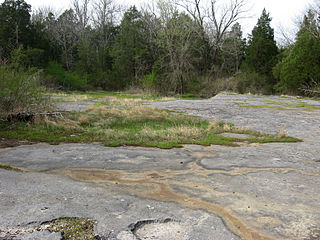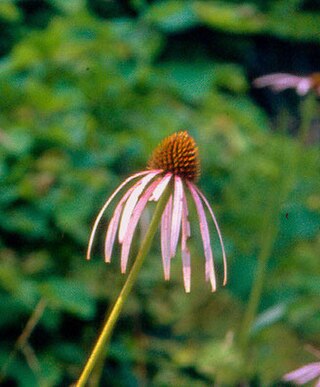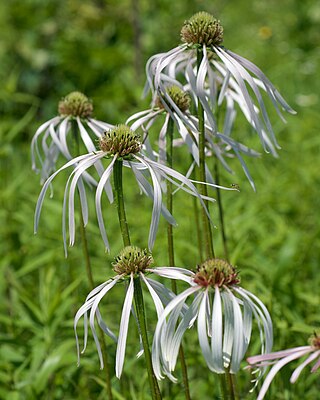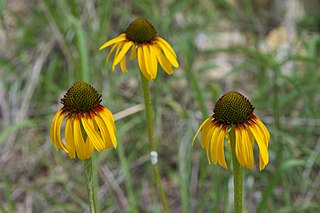
Echinacea is a genus of herbaceous flowering plants in the daisy family. It has ten species, which are commonly called coneflowers. They are native only in eastern and central North America, where they grow in wet to dry prairies and open wooded areas. They have large, showy heads of composite flowers, blooming in summer. The generic name is derived from the Greek word ἐχῖνος, meaning "hedgehog", due to the spiny central disk. These flowering plants and their parts have different uses. Some species are cultivated in gardens for their showy flowers. Two of the species, E. tennesseensis and E. laevigata, were formerly listed in the United States as endangered species; E. tennesseensis has been delisted due to recovery and E. laevigata is now listed as threatened.

Echinacea angustifolia, the narrow-leaved purple coneflower or blacksamson echinacea, is a species of flowering plant in the family Asteraceae. It is native to North America, where it is widespread across much of the Great Plains of central Canada and the central United States, with additional populations in surrounding regions.

Rudbeckia is a plant genus in the Asteraceae or composite family. Rudbeckia flowers feature a prominent, raised central disc in black, brown shades of green, and in-between tones, giving rise to their familiar common names of coneflowers and black-eyed-susans. All are native to North America, and many species are cultivated in gardens for their showy yellow or gold flower heads that bloom in mid to late summer.

A calcareous glade is a type of ecological community that is found in the central Eastern United States. Calcareous glades occur where bedrock such as limestone occurs near or at the surface, and have very shallow and little soil development. Due to the shallow soil and the extreme conditions created by it, trees are often unable to grow in the glades. This creates a habitat that is usually sunny, dry, and hot. Calcareous glade vegetation is more similar to that of a desert habitat than a grassland, being dominated by small spring annuals with occasional geophytic or succulent perennials.

Astragalus bibullatus, the limestone glade milkvetch or Pyne's ground plum, is an endangered species of flowering plant that is endemic to the cedar glades of the central basin of Tennessee in the United States. It is found in only eight populations located within a few kilometers of each other in Rutherford County, Tennessee.

Echinacea purpurea, the eastern purple coneflower, purple coneflower, hedgehog coneflower, or echinacea, is a North American species of flowering plant in the family Asteraceae. It is native to parts of eastern North America and present to some extent in the wild in much of the eastern, southeastern and midwestern United States as well as in the Canadian Province of Ontario. It is most common in the Ozarks and in the Mississippi/Ohio Valley. Its habitats include dry open woods, prairies and barrens.

Eriogonum longifolium var. harperi, also known as Harper's buckwheat or Harper's umbrella plant, is a dicot of the family Polygonaceae, found in areas of nutrient-poor shale soils in Alabama, Kentucky and Tennessee. It lives inconspicuously in an immature vegetative stage for four or more years before developing a flowering stalk, then flowers and dies. It is listed as an endangered species by the state of Tennessee. It has eleven small populations in Alabama and five in Tennessee but its survival in Kentucky is uncertain. According to a leading expert, Professor James L. Reveal of the University of Maryland, its Kentucky population has been reportedly extirpated. Its 2006 Alabama Natural Heritage Program ranking was G4T2S1, demonstrating an opinion that it was "critically imperiled" in that state.

Echinacea laevigata, the smooth purple coneflower, is a federally listed threatened species of plant found in the Piedmont of the eastern United States. Most populations are found on roadsides and other open areas with plenty of sunlight, often on calcium- and magnesium- rich soils.

Echinacea pallida, the pale purple coneflower, is a species of herbaceous perennial plant in the family Asteraceae. It is sometimes grown in gardens and used for medicinal purposes. Its native range is the central region of the United States and Ontario, Canada.

Echinacea simulata, commonly called wavy leaf purple coneflower, glade coneflower, or prairie purple coneflower, is a species of perennial flowering plant in the family Asteraceae. It is native to the east-central states of the United States. Its natural habitat is dry, calcareous, open areas such as barrens and woodlands.

Echinacea paradoxa, the yellow coneflower, Bush's purple coneflower, or Ozark coneflower, is a North American species of flowering plant in the family Asteraceae. It is native to southern Missouri, Arkansas, and south-central Oklahoma, It is listed as threatened in Arkansas.

Elsie Quarterman was a prominent plant ecologist. She was a professor emerita at Vanderbilt University.

Cedars of Lebanon State Park is a state park in Wilson County, Tennessee, in the southeastern United States. It consists of 900 acres (364 ha) situated amidst the 9,420-acre (3,810 ha) Cedars of Lebanon State Forest. The park and forest are approximately 10 miles (16 km) south of Lebanon, Tennessee.

Dalea foliosa, commonly called leafy prairie clover, is a species of flowering plant in the legume family (Fabaceae). It is an endangered species in the United States, where it occurs in three states: Illinois, Tennessee, and Alabama.

Erigeron rhizomatus is a rare species of flowering plant in the family Asteraceae known by the common names Zuni fleabane and rhizome fleabane. It is native to western New Mexico and eastern Arizona in the United States. It is a federally listed threatened species.

Lespedeza leptostachya is a rare species of flowering plant in the legume family known by the common names prairie lespedeza and prairie bush-clover. It occurs in the Upper Midwest region of the United States. The flowers are creamy-white to purplish and arranged into a narrow terminal spikes.

Astragalus tennesseensis is a species of flowering plant in the legume family known by the common name Tennessee milkvetch. It is native to the United States, where it is known from Illinois, Indiana, Tennessee and Alabama. Most of the occurrences are in Tennessee.
Leavenworthia crassa is a species of flowering plant in the mustard family, Brassicaceae, known commonly as the fleshy-fruit gladecress. It is endemic to Alabama in the United States, where it occurs in only two counties. It is "likely one of the most imperiled plant species in the Southeast," and the United States Fish and Wildlife Service issued a final rule listing it as an endangered species in 2014.

Helianthus eggertii, known as Eggert's sunflower, is a North American species of flowering plants in the family Asteraceae. It is native to Tennessee, Kentucky, South Carolina, and Alabama. It is best known as one of the few plants to have been delisted under the Endangered Species Act because of the species' recovery. It was described by John Kunkel Small in 1903.

Couchville Cedar Glade State Natural Area is a Class II Natural-Scientific state natural area located in Davidson and Wilson counties Tennessee. Its western boundary is contiguous with the eastern boundary of Long Hunter State Park. The park's name reflects its location near the now extinct inundated community of Couchville, Tennessee.





















